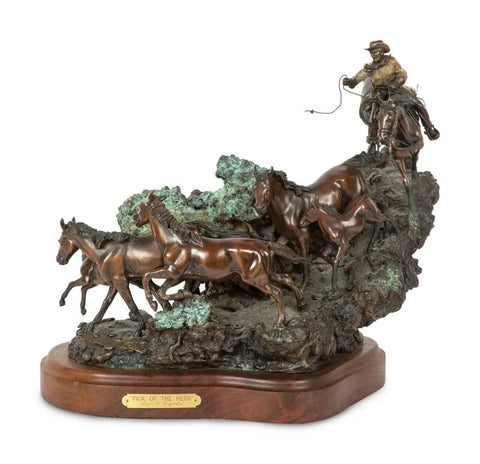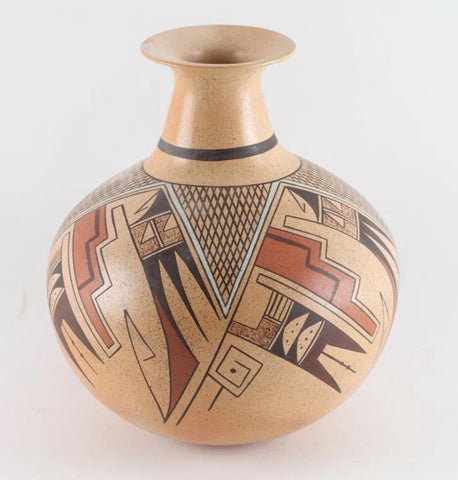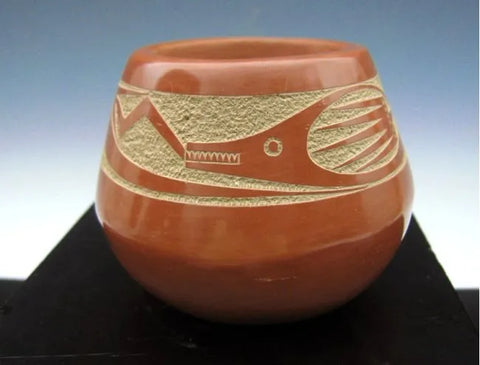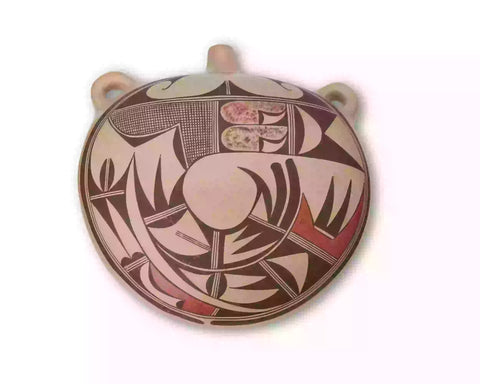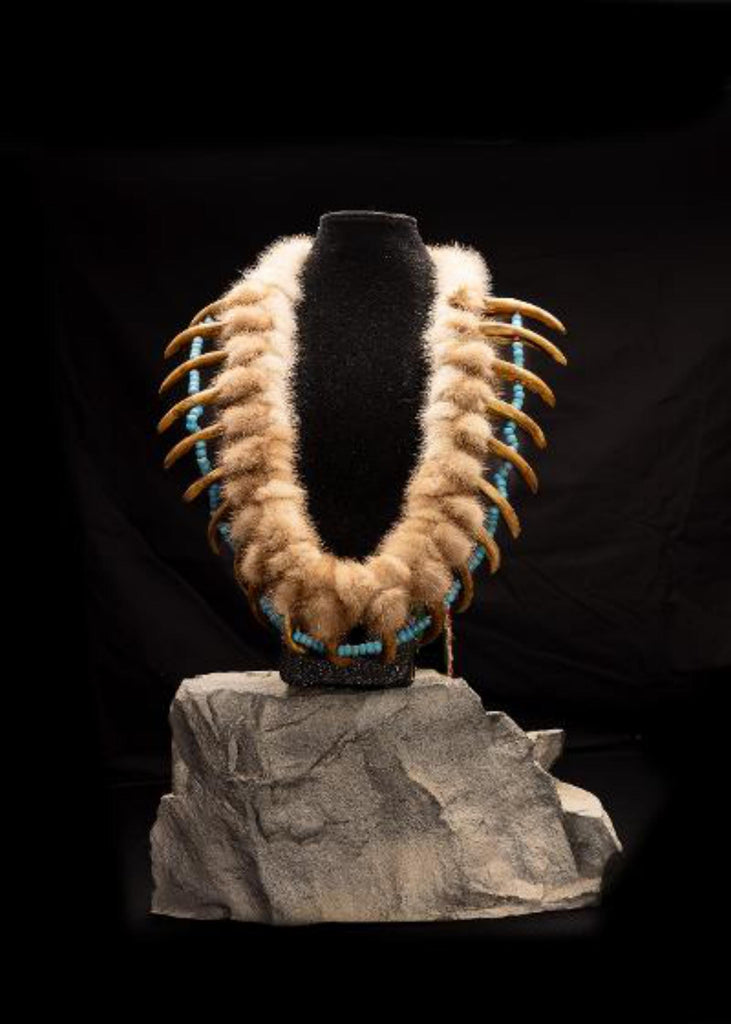
Exquisite Tishominko’s Replicate Plains Grizzly Bear Necklace, by Pali Eho, Ca 2019 C# 1706 SOLD
$ 20,000.00
Exquisite Tishominko’s Replicate Plains Grizzly Bear Necklace, by Pali Eho, Ca 2019
Tishominko’s Necklace is made of brain tanned leather that serves as the core for the necklace and base for the beadwork. The core is covered with vintage, repurposed otter fur. Twenty-one hand-made faux Plains grizzly bear claws are attached to and spaced around the otter fur core. (see discussion for historic faux precedents in museum collections)
Although the claws were molded with a proprietary substance and are technically identical, each claw has individual characteristics. Five layers of color and other coatings were used to enhance the depth of each claw, to accentuate the individual claw differences, and to create the blackened underside that a real claw would have from constant contact with soil.
The claws are spaced with antique red trade beads and antique turquoise padre beads. The back necklace is made from repurposed otter fur. The underside is painted with green mineral paint, the same substance used historically on a variety of items. The fur side of the back necklace has a large beaded rectangle that is bound with antique red trade wool.
The beadwork on the rectangle is done with antique and vintage glass seed beads using a contour 2-needle applique technique. A linear strip of beadwork is also attached to the fur side of the back necklace. It is also done with antique and vintage glass seed beads, but features linear 2-needle applique. The coloration and designs used for the beadwork were common in Prairie tribes.
The fur side of the back necklace ends with a trade silver spot that dates to the 1700’s and a piece of antique grosgrain ribbon.
Tishominko’s Necklace is 46” long when spread out. It is 18” wide at the center of the front necklace. The back necklace is 29” long x 6” wide. Tishominko’s Necklace took nearly one year in order to assemble the antique materials and to complete the beadwork. Tishominko’s Necklace took 1st in the Mixed Media category of the June 2020 Nevada Artist’s Association Spirit of America art show in Carson City, Nevada. In this show, the necklace competed with glasswork, sculpture, ceramics and jewelry among other mixed mediums.
ARTIST
Pali Eho is the artist who created Tishominko’s Necklace and is an enrolled member of the Chickasaw Nation of Oklahoma who resides in Nevada.
Having graduate level degrees in wildlife and fisheries sciences, Pali Eho spent a career working as a federal wildlife habitat biologist. Due to having grown up on the Great Plains of Kansas, Pali Eho has
been significantly influenced by Plains Indian material and has been a lifelong student of Native American art. Pali Eho has been creating a few historic based Native American material pieces each year for over 50 years. Examples have been shown in the Washington D.C. Department of the Interior’s Indian Craft Shop. Some pieces have been shown in both open and Native American art shows and have taken 1st prize awards including in the Gallup Inter-Tribal Indian Ceremonial art show.
PLAINS GRIZZLY BEAR NECKLACE
HISTORY
The grizzly bear, Ursus arctos horribilis, had several historic forms based on their habitat. (Modern genetic testing reveals the grizzly to be a subspecies of brown bear (Ursus arctos). However, North America only one species of grizzly (Rausch 1953) or horribilis. The mountain grizzly bear is still extant and lives in the Rocky Mountain Region of the Western U.S. Historically, another grizzly bear form, the Plains grizzly, ranged far eastward on the shortgrass and mixed-grass prairies of the Great Plains of the American West (Environment Canada 2009). The bear occupied most of the Dakotas and the far western reaches of Nebraska, Kansas and Oklahoma as well as extreme West Texas. Rather than roaming widely over the sprawling plains, Plains grizzlies likely clung to the gallery forests and brushy thickets of prairie watercourses most of the time. Besides the lush greenery and abundant fruit in the river corridors, Plains grizzlies once had the huge bison herds to feed on (Mattson et al. 2002). The animal was revered by native people that lived in the Great Plains region (Painter 2002).
One of the earliest travelers to explore and document Native Americans, wildlife and other natural resources on the Great Plains was German-born Maximillian, Prince of Wieds. In his narrative, he stated "The Mandans and Manitaries [Hidatsas], and all the Indians of the Upper Missouri, often wear the handsome necklace made of the claws of the grizzly bear. These claws are very large in the spring, frequently three inches long, and the points are tinged of a white color, which is much esteemed; only the claws of the fore feet are used for necklaces, which are fastened to a strip of animal skin, lined with … cloth … which hangs down the back like a long tail.” (Reuben Gold Thwaites 2006).
Later, in the early 1800s, when Captains Meriwether Lewis and William Clark led their Corps of Discovery westward from St. Louis to explore possible water routes to the Pacific, they also encountered the Plains grizzly bear and the Plains Indians. The Plains grizzly bear impressed Lewis and Clark: “A most tremendous looking animal,” Lewis wrote in May 1805, “and extremely hard to kill.” The Plains grizzly could stand 9 feet tall and could weigh 1000 pounds (Painter 2002). Lewis and Clark saw Plains Indian men wearing necklaces made from Plains grizzly bear claws and collected two of these during their journey (www.lewis-clark.org/article/3043).
Grizzly bear Claw necklaces, especially those necklaces made from the extinct Plains Grizzly, have always been prized possessions of Native American Indians (McLaughlin 2003). Plains claws were more attractive than the more common mountain grizzly bear claws because they were strikingly uniform in their light, yellow color (McLaughlin 2993). Additionally, they were considerably longer. They grew longer because the Plains grizzly moved about in a territory with softer soil while the mountain grizzly tended to wear his claws down in a more mountainous habitat (Painter 2002).
Plains grizzly necklaces were worn by men from many tribes in the Great Plains region (www.lewis-clark.org/article/3043). Even though their use was widespread, grizzly necklaces were not common; any one tribe might have only a few wearers because of the difficulty in obtaining the claws (Feder and Chandler, 1961). Even when the Plains grizzly bear was numerous, it was a difficult animal to hunt and slay (https://forums.powwows.com/f13/grizzly-bear-claw-necklace-50522/).
The grizzly bear claw necklace was worn on important occasions and then only by distinguished individuals, who, through acts of bravery had earned the right to wear this necklace (Warnock and Warnock, 2009). The wearer had either collected enough bear claws as a hunter to wear the necklace, or had slain an enemy that had a bear claw necklace. This latter gave the victor the right to wear the necklace (Conklin, 1986). Bear claw necklaces were singular prestige items that could also be given spontaneously as an act of honoring another (www.lewis-clark.org/article/3043).The necklace was not only highly decorative, but it was the visual transfer of power from bear to wearer (Warnock, and Warnock 2009).
Historically, Euro-Americans killed grizzly bears as livestock predators and generally drove it from its Great Plains homeland by killing the bison nearly to extinction, and by turning the old buffalo steppes into grain fields and cattle ranches. The Plains grizzly became virtually extinct more than 145 years ago (Painter 2002).
In later years, with the depletion of the Great Plains Grizzly Bear, many tribes made claw necklaces from Rocky Mountain Grizzly bear claws or from carved elk antler. One Elkhorn faux grizzly bear claw necklace was collected in 1838 and resides in the American Museum of Natural History. Another faux grizzly bear claw necklace was collected among the Crow and dates to the 1870s. It is made of horse hooves carved in the shape of bear claws, covered by "layer upon layer" of red ochre—evidence, according to Conn, that the maker was responding to a spiritual vision (Conn 1979). There are several faux grizzly bear claw necklaces in Harvard’s Peabody Museum collections, and Feder and Chandler note that necklaces of this type are neither uncommon nor a recent phenomenon. (Feder and Chandler 1961) (www.lewis-clark.org/article/3043).
Federer and Chandler warned that, "Very little can be stated as absolute fact concerning the differences in necklace construction by different tribes," due to the scarcity of examples, the wide range of forms worn by members of the same culture, and the complications of trade.
A common style of making the Plains grizzly bear claw necklace among the Prairie Tribes such as the Ponca, Osage, Iowa, Pawnee, and Missouri tribes has been described by Feder as consisting of “claws with double perforation, mounted on a core covered with otter fur. A core that forms a continuous circle and a tail composed of a separate otter skin pendant down the back” (Feder and Chandler 1961). Mails also describes this general composition used by Plains tribes (Mails 1972) Usually only the longer front claws were used since the back ones were significantly shorter. Large glass trade beads were often used as spacers between the claws, strung halfway down the claw at the secondary perforation (https://forums.powwows.com/f13/grizzly-bear-claw-necklace-50522/).
The Chickasaw Tribe was first contacted by Euro-Americans in northern Mississippi. They controlled part of the Mississippi River as well as a territory that included lands in several of today’s states. The U.S. Department of War forcibly removed the Chickasaw people from Mississippi, Kentucky, Alabama and Tennessee in 1837. Although the Chickasaw Nation negotiated a settlement for lands lost in the southeast and used funds to purchase new lands from other Tribes already in Oklahoma Territory, individual Indians were given only a few hours to sell their possessions and holdings before they left under U.S. Army guard. Some of the possessions included cotton crops, land, livestock and businesses. Pennies on the dollar were paid by incoming Euro-American settlers for these valuable holdings. The Chickasaw journey to Indian Territory in Oklahoma was part of Andrew Jackson’s plan that culminated in the “Trail of Tears” removal of Native Americans from the Southeastern U.S.
Chief Tishu Miko (now written as Tishominko) 1735-1837, was born in Mississippi and has come to be remembered as one of the last great chiefs of the Chickasaws. Tishominko, means "King's Assistant" or "Servant King," Tishominko passed away in Arkansas from small pox on his way to Oklahoma Indian Territory. The present capital city of the Chickasaw Nation carries his name and the Great Seal of the Chickasaw Nation bears his image as a symbol of what it means to be Chickasaw (www.chickasaw.net/hall).
Today, a larger-than-life bronze statue of Tishominko stands in front of the Chickasaw Nation Cultural Center in Sulfur, Oklahoma. Tishominko wears a bear claw necklace. Since a bear claw necklace could be given from one revered leader to another, especially a warrior chief, it could be speculated that the necklace was a gift from a Great Lakes tribe that would have been in contact with the Chickasaws while they were in northern Mississippi. It could also be speculated that because Tishominko was a renowned war leader, that he acquired and fashioned the claw necklace himself since Chickasaw hunters and warriors frequently travelled to the eastern Prairies.
NARRATIVE REFERENCES
Conklin, Abe. 1986. Ponca / Osage. Personal Interviews conducted by Powwows.com
Conn, Richard. 1979. Native American Art in the Denver Art Museum. U of Washington Press. 350 pp.
Environment Canada. 2009. “Recovery Strategy for the Grizzly Bear (Ursus arctos), Prairie Population, in Canada. Species at Risk Act Recovery Strategy Series”. Environment Canada, Ottawa. v + 28 pp.
Feder, Norman and Milford G. Chandler. 1961. “Grizzly Claw Necklaces”. American Indian Tradition Newsletter, Vol. 8, No. 1.
Mails, Thomas E. 1972. The Mystic Warriors of the Plains. Garden City, New York: Doubleday, 618 pp.
Mattson, David et al. 2002. Conservation Biology. August. 16(4): 1123-1136.
McLaughlin, Castle. 2003. Arts of Diplomacy: Lewis and Clark’s Indian Collection. Peabody Museum of Archaeology and Ethnology, Harvard University, Cambridge, MA. 359 pp.
Reuben Gold Thwaites, ed. 2006. Maximilian, Prince of Wied’s Travels in the Interior of North America, Vol. 2 in Early Western Travels, 1748-1846 (Cleveland, OH: Arthur H. Clark) 24:262.
Painter, John W., A Window on the Past, Early Native American Dress from the John Painter Collection, Cincinnati Art Museum, 2002, p. 21, fig. 13. Catalogue from the Exhibition. 2002. Exhibit Oct 13, 2002 through March 30, 2003.
Rausch, Robert (1953). "On the status of some arctic animals". Arctic. 6 (2): 91–148. doi:10.14430/arctic3870
Warnock, John and Marva Warnock. 2009. Splendid Heritage: Perspectives on American Indian Arts. Catalogue of an exhibition at the Utah Museum of Fine Arts. Art can be viewed at www.splendidheritage.com. Or google splendid heritage exhibit. Grizzly necklace page 108 in catalogue. #WC8708308 on website collection.
www.chickasaw.net/hall
www.lewis-clark.org/article/3043. Awakening the Bear.
www.forums.powwows.com/f13/grizzly-bear-claw-necklace-50522/
OTHER REFERENCES
Barrett, Jay Amos.1898. Ponca Indians. Proceedings and Collections of the Nebraska State Hist. Soc., 2nd Series, Vol. 2, NE.
Barth, Georg J.1993. Native American Beadwork. R. Schneider Publishers, Stevens Point, WI.
Bowers, Alfred W. 1992. Hidatsa Social and Ceremonial Organization (Lincoln: University of Nebraska Press)
Callahan, Alice A. 1990. The Osage Ceremonial Dance, I’n-Lon-Schka. Univ. of Oklahoma Press, Norman.
Catlin, George 1841. Letters and Notes on the Manners, Customs and Traditions of North American Indians. 2 Volumes, Tosswill & Myers, London, England. (Reprinted as Letters and Notes on the North American Indian. Ross and Haynes, Inc., Minneapolis, MN, 1965)
----------1844. Letters and Notes on the Manners, Customs, and Condition of the North American Indians, 2 vols. (repr., New York: Dover, 1973), 1:146.
Connelley, William E. 1918. Notes on the Early Indian Occupancy of the Great Plains. Kan St Hist Soc. Coll, 1915-1918, Vol. 14.
Denig, Edwin Thompson. 1930. The Assiniboine (repr. with a new introduction by David R. Miller, Norman: U of OK Press, Norman 2000).
----------1961. Five Indian Tribes of the Upper Missouri. University of Oklahoma Press, Norman, OK.
Dorsey, George Amos.1904-a. Traditions of the Skidi Pawnee. Memoirs, American Folk-lore Society, Vol. 8.
----------1904-b. Traditions of the Osage. Field Museum of Natural History, Chicago, IL.
Dorsey, Rev. James Owen. 1884-a. Omaha Sociology. Bureau of American Ethnology, 3rd Annual Report 1881-82, Smithsonian Institution, Washington, D.C.
----------1894. A Study of Siouian Cults. Bureau of American Ethnology, 11th Annual Report 1889-90, Smithsonian Institution, Washington, D.C.
---------- and Cyrus Thomas.1907. Iowa. Handbook of American Indians North of Mexico, Bureau of American Ethnology, Bulletin 30, Part 2, Smithsonian Institution, U.S. Government Printing Office, Washington, D.C.
---------- 1910. Ponca. Handbook of American Indians North of Mexico, Bureau of American Ethnology, Bulletin 30, Part 2, Smithsonian Institution, U.S. Government Printing Office, Washington, D.C.
Ewers, John Ewers. 1955. "The Bear Cult Among the Assiniboins and their Neighbors," Southwestern Journal of Anthropology, vol. 11, no. 1, 131-145.
Howard, Dr. James H.1955. The Pan-Indian Culture in Oklahoma. The Scientific Monthly, Vol. 81, No. 5.
----------1976. Ceremonial Dress of the Delaware Man. Special Issue, The Bulletin of the Archeological Society of New Jersey, No. 33, Seton Hall University, South Orange, NJ.
Hyde, George E.1951. The Pawnee Indians. University of Denver Press, Denver, CO.
Lowie, Robert H. 1916. Plains Indian Age Societies: Historical and Comparative Study. Anthropological Papers, American Museum of Natural History, Vol. 11, Part 13, New York, NY.
Lowie, Robert H., Ed. Clark Wissler. 1916. Societies of the Plains Indians. Anthropological Papers, American Museum of Natural History, Vol. 9, New York, NY.
Meadows, William. 1999. Kiowa, Apache and Comanche Military Societies. U of Texas Press, Austin.
Murie, James R. 1914. Pawnee Indian Societies. Anthropological Papers, American Museum of Natural History, Vol. 11, No. 7, New York, NY.
Orchard, William C.1929. Bead and Beadwork of the American Indians. Contributions from the Museum of the American Indian, Vol. 11, Heye Foundation, New York, NY.
Skinner, Alanson B. 1915-a. Societies of the Iowa, Kansa and Ponca Indians. Anthropological Papers, American Museum of Natural History, Vol. 11, Part 9, New York, NY.
Swanton, John R. 1910. Osage. Handbook of American Indians North of Mexico, Bureau of American Ethnology, Bulletin 30, Part 2, Smithsonian Institution, U.S. Government Printing Office, Washington, D.C.
Thompson, Edwin.1928. The Indian Tribes of the Upper Missouri. Bureau of American Ethnology, 46th Annual Report 1924-25, Smithsonian Institution, Washington, D.C.
Unrau, William. 1971. The Kansa Indians: The History of the Wind People. Un of OK Press, Norman.
Wissler, Clark.1906. Diffusion of Culture in the Plains of North America. Proceedings of the International Congress of Americanists, Vol. 15, Quebec, Canada.
---------- 1915. Costumes of the Plains Indians. Anthropological Papers, Am Mus of Natural History, Vol. 17, No.2, NY.
Museum, Gallery and Auction Specimen References
Gallery
Cisco Gallery. Plains Style Bear Claw Necklace. Item #Z66. Made after 1950.
Auctions
Live Auctioneers. Cowans Auction. Oct 10, 2019. Lot 0117. Plains Imitation Bear Claw Necklace created in mid- 1900..
Skinner Auction. February 11, 2013. Lot 78. Pawnee-style Bear Claw Necklace. Assembled by Milford Chandler with additions by Joseph Rivera. Claws are real 19th century Plains Grizzly.
Museum / Historic Necklaces / Photographs
American Cowboy Chronicles, The. Native American Indian Folklore & Symbols – The Bear. Tom Correa author. Sunday, May 10, 2015. Photograph of antique Sioux Bear Claw Necklace and photograph of modern Pawnee Style Necklace.
Bailey, Garrick, and Daniel Swan.2004. Art of the Osage. St. Louis Art Museum, U of WA Press, Seattle.
Bear Claw Necklace, Chahiksichahiks (Pawnee), ca. 1830. The Paul Dyck Plains Indian Buffalo Culture Collection, Buffalo Bill Center of the West. NA.203.1413
Bear Claw Necklace. ca . 1840. National Museum of the American Indian, Smithsonian Institution, Washington, D.C. (088020.000)
“Bear Claw Necklace (Pawnee)”. Dr. John P. Lukavic, Denver Art Museum and Dr. Steven Zucker, in Smarthistory, January 10, 2018. www.smarthistory.org/bear-pawnee/
Buffalo Bill Center of the West. Paul Dyke Plains Indian Buffalo Culture Collection. Pawnee Grizzly Bear Necklace.
Ewers, John Ewers. 1982. "The Awesome Bear in Plains Indian Art," American Indian Art, vol. 7, no. 3.
Hanson, James. 1994. Spirits in the Art: From the Plains and Southwestern Indian Cultures (Kansas City: The Lowell Press, Inc.).
Johnson, Tim. Ed.1998. Spirit Capture: Photographs from the National Museum of the American Indian. Smithsonian Books, Washington, D.C.
Flint Institute of Arts ;1973. Art of the Great Lakes Indians, Flint Michigan.
McLaughlin, Castle. 2003. Arts of Diplomacy: Lewis and Clark’s Indian Collection (Cambridge, Massachusetts and Seattle: Peabody Museum of Archaeology and Ethnology and University of Washington Press.
Penney, David W. 1992. Art of the American Indian Frontier: the Chandler-Pohrt Collection (Detroit: Detroit Institute of Arts), Plate 46.
Photograph. Otoe Delegation, January 1881 Wash. D.C. John K Hillers. Adolf Speer Collection. P.42-203.
National Museum of the American Indian. T141174 Grizzly Necklace.
Smithsonian American Art Museum. Shon-ta-yi-ga, Little Wolf, a Famous Iowa Warrior by George Catlin 1844. Acc. No. 1985.66.521
Warnock, John and Marva. 2009. Splendid Heritage: Perspectives on American Indian Arts. Catalogue of an exhibition at the Utah Museum of Fine Arts. Art can be viewed at www.splendidheritage.com. Or google splendid heritage exhibit. Grizzly necklace page 108 in catalogue. #WC8708308 on website collection.














